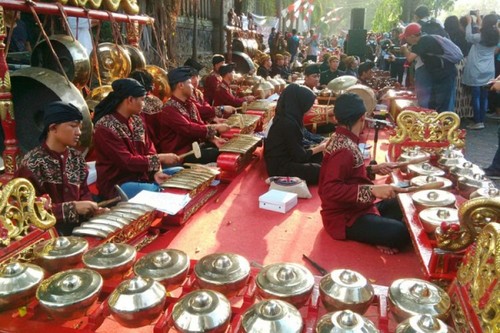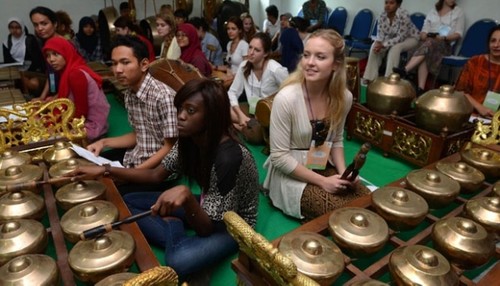Gamelan represents a native art form that predated the Hindu-Buddhist culture that dominated Indonesia after 404 BC.
I Made Bandem, a gamelan master, explains what gamelan is and how it’s played: “Gamelan has three important aspects: material, music, and function. A gamelan set is the percussion orchestra of Indonesia, which is comprised of slab gongs and bossed gongs. There is also a stringed instrument –the zither – and bamboo flutes. Gamelan is played by beating, tapping, bowing, plucking, or blowing.”
“The common tunings of gamelan are pentatonic or septatonic with diverse scales, intervals, and tones. Gamelan instruments are tuned in high-low pairs, which, when played together, create beats or vibrato. Gamelan music has some unique playing techniques, such as heterophony, variations of the same melody played simultaneously by different instruments, and interlocking figuration, where two different melodic lines played simultaneously interlock to create a synthesis that is more complex and alluring,” said Bandem.
In a gamelan ensemble, a hand drum called a kendhang sets the tempo and rhythm and leads the transition from one section to another, while another instrument gives melodic cues to indicate the treatment of the current section of the piece.
A bamboo flute enhances the timbre or tone color. A xylophone consists of 18 bamboo sticks placed on a boat-shaped resonator and arranged from small to large to create a musical scale.
The most unusual gamelan set consists of 10 bossed gongs with the boss, or nipple, facing up toward the ceiling. Gamelan artists use cloth-covered or rubber-coated mallets to play octave notes to open a piece of music.
Archaeological evidence of gamelan instruments has been found in the bas-reliefs of the Borobudur and Prambanan temples.
There are variants of Indonesian gamelan that correspond to different periods of history and differences in geography, but the distribution of gamelan in Indonesia centers on Central Java, the Special Region of Yogyakarta, and Bali. Today almost every province in Indonesia has gamelan.
 A gamelan performance in Yogyakarta city (Photo: Kompas) A gamelan performance in Yogyakarta city (Photo: Kompas)
|
Listiana Wijaya, a female artist of a 3-generation gamelan family in Yogyakarta city, said, “Over time, the gamelan ensemble evolved and could be combined with a variety of other instruments. Gamelan music varies from region to region. For example, gamelan music in Java is often slow and deep while the music in Bali is faster, more dynamic and joyful. The gamelan music in Lombok and Madura has a lot of flute and is more rhythmic. Gamelan can be played by a single artist or multiple people.”
Today gamelan is part of the daily life of people across Indonesia. It is typically performed for religious rituals, ceremonies, traditional theatre, festivals, and concerts, conveying mutual respect, love, and compassion, said Samuel Arif Prasetyo, an Indonesian priest.
“A gamelan accompaniment is used in processions expressing our faith through music and has become an integral part of church life,” Samuel explained.
Communities get economic benefit from selling gamelan instruments and accessories, and from performances. Gamelan is also used for psychotherapy, reducing the joint pain of osteoarthritis, controlling hypertension, and increasing emotional intelligence.
Dr. Aliyah Himawati Rizkiyani, a psychiatrist, said, “With gamelan therapy, the patient becomes more relaxed, feels happier, and this leads to a more rapid recovery.”
Gamelan ensembles promote gender equality and discourage gender discrimination. In education, gamelan strengthens character, according to Widodo Wilis, founder of the Muslim Boarding School Hanacaraka.
According to Widodo, “Our goal is for the children to feel that they have their own culture, because if they love their own culture, it will be the same as loving Indonesia.”
 Foreigners are eager to learn traditional gamelan instruments. Foreigners are eager to learn traditional gamelan instruments. (Photo: Kompas)
|
Nadiem Makarim, Indonesia’s Minister of Tourism and Creative Economy, said, “For us Indonesians, gamelan has a very long history. Since the 5th century, gamelan has been an indispensable part of our life, particularly in Java, Bali, Madura, and Lombok. Gamelan is performed on many occasions, for a number of purposes. Because of the importance of gamelan to Indonesians, UNESCO has been working very closely with local governments and communities to conserve it as a cultural heritage. We support local artists and art centers to help them prosper. We promote gamelan through school courses, competitions, art performances, and training workshops.”
Gamelan has been known internationally for a long time. Several countries, including the US, the UK, Australia, and Canada have developed gamelan education programs.
Mohamad Oemar, Indonesian Ambassador to France, Andorra, and Monaco and representative of the Permanent Mission of the Republic of Indonesia to UNESCO, said that gamelan has long been used as a tool of diplomacy.